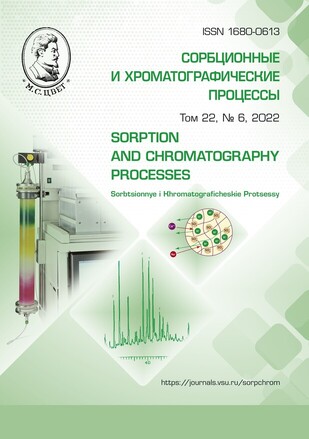Self-sustaining processes for the softening and desalination of underground brackish water
Abstract
This work describes numerical experiments involving a large number of interconnected successive cyclic sorption-regeneration processes on a strongly acidic cation exchanger. These experiments were used to develop a process flow for a self-sustaining process for the softening and desalination of a multicomponent solution simulating the composition of real underground brackish water. Such water, whose macrocomponents include sodium, potassium, calcium, and magnesium cations, as well as chloride, sulphate, and bicarbonate anions, are common in nature, for example, in the underground springs of the Crimean peninsula. Despite their low salinity, nonetheless, they are not suitable neither for drinking, nor for irrigation. The paper considers a cheap reagent-free method for purifying such water, which uses the brine left after desalination as solution for regenerating the sorption column in each cycle. The presence of sulphates makes ion-exchange softening and desalination processes more challenging, since, firstly, molecular complexes of calcium and magnesium sulphate are formed in the initial solution, and secondly, low-soluble calcium sulphate salts can be deposited in the distiller concentrate compartments. Therefore, it is necessary to remove sulphates with the help of nanofiltration membranes that retain two-charged ions. The concentrate left after nanofiltration can be used for the production of fertilizers, while the permeate is fed to the destiller. In addition, the paper investigates desalination modes and clarifies the dependence of the presence of the self-sustaining process for softening and desalination on the concentration of the regeneration solution obtained after the destiller.
Downloads
References
Muraviev D.N., Khamizov R.Kh., Tikhonov N.A., J. Gómez Morales. Clean ("Green") Ion Exchange Technologies. IV. Development of Sorbent for Self-sustaining Decalcification of Mineralized Waters. Ind. Eng. Chem. Res. 2004; 43(8); 1868-1874.
Tokmachev M.G. Tikhonov N.A., Khamizov R.Kh. Investigation of cyclic self-sustaining ion exchange process for softening water solutions on the basis of mathematical modeling. React. Funct. Polym. 2008; 68(8): 1245-1252.
Khamizov R.Kh., Komarova I.V., Galkina N.K., Prudkovskii A.G. Self-Sustaining Processes of Water Softening and Desalination: Simple Two-Component Systems. Theoretical Foundations of Chemical Engineering. 2020; 54(5): 919-930. (In Russ.)
Khamizov R. Kh., Komarova I.V., Galkina N.K., Prudkovskii A.G. Self-Sustaining Water Softening-Desalination Processes: Chloride-Sulfate Systems. Theoretical Foundations of Chemical Engineering. 2022; 56(2): 186-199. (In Russ.)
Komarova I.V., Galkina N.K., Prudkovskii A.G., Khamizov R.Kh. Math-ematical simulation and calculation of the process of water demineralization in industrial filter part 1. Hydrodynamics of regen-eration and washing of industrial filter. Sorbtsionnye I Khromatograficheskie Protsessy, 2017; 17(1): 10-19. (In Russ.)
Prudkovskii A.G., Khamizov R.Kh., Komarova I.V. Existence criteria for self-sustaining processes of water softening and desalation for simple two-component sys-tem. Sorbtsionnye I Khromatograficheskie Protsessy. 2022; 22(4): 377-385. https://doi.org/10.17308/sorpchrom.2022.22/10564 (In Russ.)
Lurie Y.Y. Handbook of analytical chemistry. M., Chemistry, 1971. 261 p. (In Russ.)
Amir Abbas Izadpanah, Asghar Ja-vidnia. The Abilityofa Nanofiltration Membraneto Remove Hardnessand Ionsfrom Diluted Seawater. Water. 2012; 4: 283-294.







